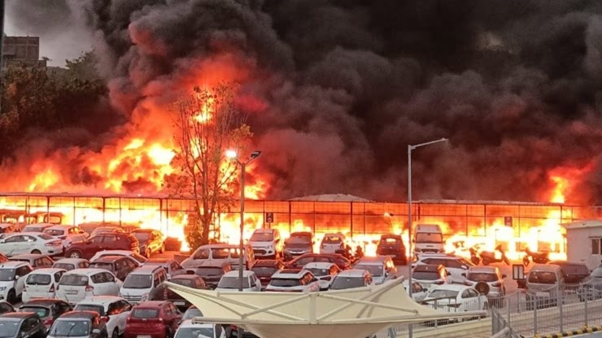Background
The increasing popularity of electric vehicles (EVs) in tandem with the global push for a greener environment has resulted in the installation of more charging stations worldwide. However, recent news of EV charging station fires and risks has raised concerns. For instance, in India, as shown in Figure 1, 100 vehicles parked at an EV charging station caught fire due to a potential short circuit, and in Melbourne, a fire broke out at a Tesla charging station that quickly spread to the electrical box. Fire risks and EV concerns extend beyond charging station issues, to things like a compromised battery, spontaneous combustion, and fires during crashes.

Figure 1. Fire erupts in a carpark in Delhi, India with EV charging stations (Indian Express)
The United Firefighters Union highlights the risks of lithium-ion batteries potentially exploding when they ignite or overheat. When compromised, the energy stored is released in a process called 'thermal runaway.' If there are issues with the charging stations' built-in safety measures, a spark could facilitate a quickly spreading fire. When EV fires occur, the risks and consequences are enormous. As aptly summarised by a firefighter in an ABC news interview EVs, "cause fires that are extremely difficult to extinguish, while releasing an extraordinary array of deadly toxic gases…when they (EV fires) happen the risks are huge and the consequences are enormous."
Why is this happening?
Electrical vehicle charging stations are electrical fixtures and carry the same risks as any other electrical appliance. Malfunctions due to electrical faults may occur as high voltages are transferred from the charging stations to the EV, posing a potential fire hazard. Additionally, lithium-ion batteries are sensitive to elevated temperatures and can self-ignite if the faults contribute heat to the system. Research shows that most fires and explosions occur during charging.
f the battery itself becomes compromised due to this or any other form of unnoticed mechanical damage, small amounts of gas and heat are released in a process called "off-gassing." Consequently, "thermal runaway" occurs, and the heat inside the car's battery cell rises too quickly to dissipate. This process feeds off the flammable vapours released during the "off-gassing," resulting in the car bursting into flames. As EVs continue to gain popularity, or if a compromised EV is parked in a parking garage, fire can spread to surrounding vehicles. In-range EVs may also be subject to the same "thermal runaway" process, leading to a catastrophic chain reaction.
What can we do?
To reduce the risk of fires at EV charging stations, it is crucial to adhere to the regulations set out by the National Construction Code (NCC) regarding electrical installations. This ensures that EV charging stations are installed and maintained safely. Additionally, regular maintenance of the EV battery and its charging equipment, along with proper handling of the battery, can help prevent fires. Overcharging the battery should be avoided, and EVs should be parked away from other vehicles and structures to prevent fires from spreading.
As the popularity of EVs continues to rise, it is essential to prioritise safety measures to prevent accidents and fires. The fire brigade and fire safety engineers are actively researching this emerging risk, so it is important for designers to consider significant safety factors and flexibility into buildings and infrastructure. This ensures that future changes can be easily introduced once the research has caught up.
It is crucial to recognise the potential risks associated with EV charging stations and take appropriate measures to minimize them. By following regulations, performing regular maintenance, and proper handling, we can ensure the safety of EV users and the surrounding environment.
Conclusion
In conclusion, the rise of electric vehicles and EV charging stations has brought about new safety concerns. The potential risks of EV charging station fires are significant, and it is essential to follow safety regulations and maintain proper handling and maintenance procedures to minimize these risks. As EVs continue to gain popularity, it is crucial to prioritize safety measures and consider flexibility in building and infrastructure design to allow for future changes. The ongoing research by fire safety engineers and the fire brigade should be used to continually improve safety measures and mitigate any potential risks. By taking appropriate safety measures, we can ensure the safety of EV users and the surrounding environment.
